The Telegraph
A. Needle Telegraphs
| If you are British, you know that the telegraph was invented
by Charles Wheatstone and Charles Cooke in 1836-37, An example of this form
of Needle Telegraph is shown at the right; it is at Glasgow University and
was made by George Mason & Co. of Glasgow. In some early instruments a
number of wires were used to energize coils which pointed a compass needle
toward different letters. In the single-needle model the needle deflects
right and/or left, giving the equivalent of the familar dots and dashes in
the American Morse coad. Under each letter on the face of the instrument
can be seen the deflections indicating each letter.
The telegraph instrument shown below in front and back
views is in the Museum at the University of Mississippi. This is a single-needle
device (the needle is missing). I think that the horizontal dial controls
a rheostat, allowing different currents to be sent down the connections to
the receiving instrument.
|
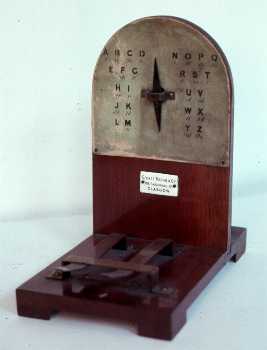
|
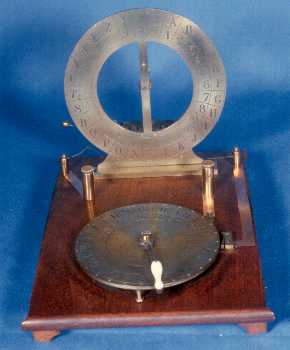
|
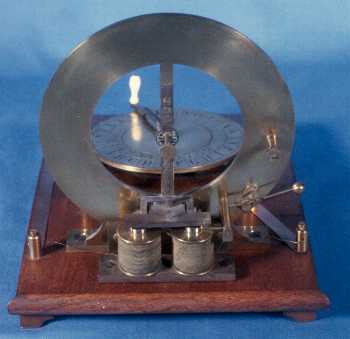
|
The separate transmitting and receiving single-needle instruments
below are from Grinnell College. They are listed at $15.00 in the 1881 catalogue
of James W. Queen of Philadelphia; this price included a battery.
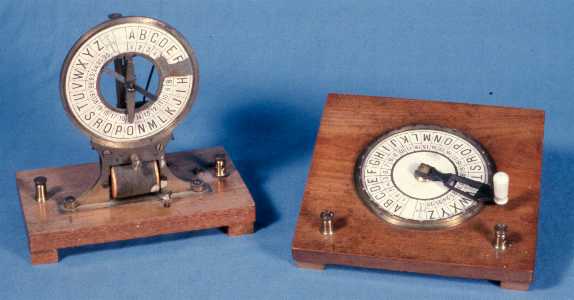
|
| This transmitter-receiver pair is in the collection of Vanderbilt
University. It was made by Ruhmkorff of Paris, and was purchased about 1875
when the first apparatus collection at Vanderbilt was assembled.
The description of the apparatus is: The transmitter
and receiver consist "of a brass ring of diameter about 21.7 cm covered by
two plates of glass and enclosing a paper dial on which are printed the 26
letters of the alphabet. Also enclosed in each are a toothed wheel whose turning
produces impulses in an electromagnet located in the indicator. By turning
the first dial to the letter to be transmitted, the operator causes a corresponding
number of impulses to actuate the electro- magnet an equal number of times
and the dial accordingly stops at the desired point. A battery is located
at the manipulator and the two instruments are connected by two wires."
This is drawn from Robert T. Lagemann The Garland
Collection of Classical Physics Apparatus at Vanderbilt University, (Folio
Publishers, Nashville, TN, 1983), pg 113
|
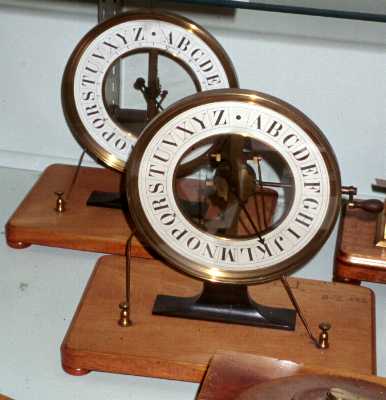
|
B. Electromagnetic Telegraphs
Americans know perfectly well that the telegraph was invented
by the artist and scientist Samuel Finley Breese Morse (1791-1872), who conceived
the idea of the printing telegraph during an ocean voyage to Europe in 1832.
The actuation of an electromagnet in the receiver would cause a pencil to
make marks on a continuously-moving strip of paper. The first instrument
was made in 1836, and improved after Morse contacted Joseph Henry. The use
of the relay to allow the signal to be retransmitted to increase the range
was invented by Morse, Henry, Wheatstone and Siemens. The first long-distance
line was constructed between Washington and Baltimore with the assistance
of federal funds, and the first message sent May 24, 1844.
Printing or recording receivers similar to the one in the
picture at the left, below, were originally used. This improved model, dating
from the 1870s, used a clockwork mechanism to pull a long strip of paper
past a sharp point which was pushed into the paper by the electromagnet. Early
on, the operators learned to distinguish the long and short sounds as the
electromagnet clicked in and out, and relied almost exclusively on the sound,
writing down the letters of the message by hand. It was sold by James W.
Queen of Philadelphia at a relatively hefty price of $50.00. It is in the
apparatus collection of Washington and Lee University.
At the right below is a telegraph sounder, ca. 1900, made
by the American Telegraph Company, and in the Greenslade Collection.
Recording telegraph receivers were also made by Daniel Davis.

|
Early telegraph keys are rather uncommon, and I used the
device at the left at Kenyon College as an ordinary tap switch for thirty
five years before I realized that it was a "Plain Signal Key for closing and
opening circuit at will. Of brass, on a polished mahogany base ....$1.50"
-- from the 1881 Queen catalogue. |
| This form of telegraph key was used by high-speed telegraphers.
This key was used by T.B. Howe about 1890 for land
telegraphy. His son, Richard Howe, was a long-time member of the Denison
University physics department, and retired ca. 1965. The instrument was made
by Foote, Pierson & Co. of New York
|
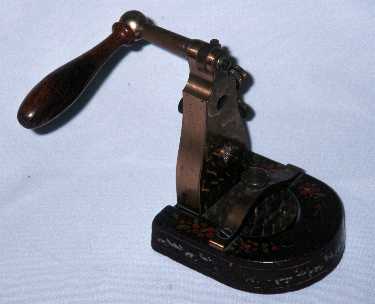
|
Return to Electricity
Home Page | Return to Home Page